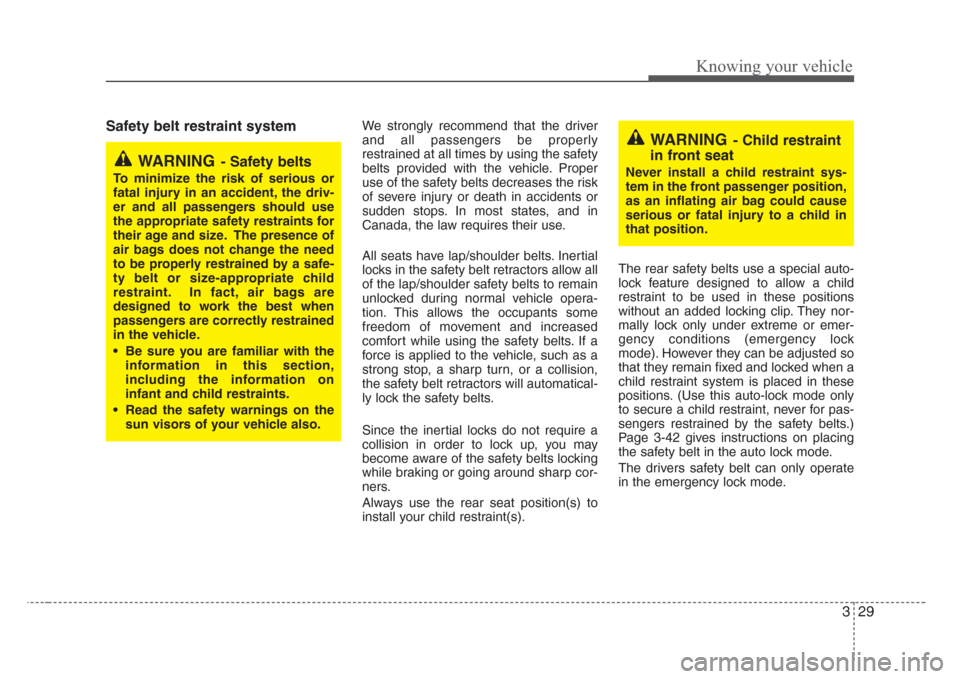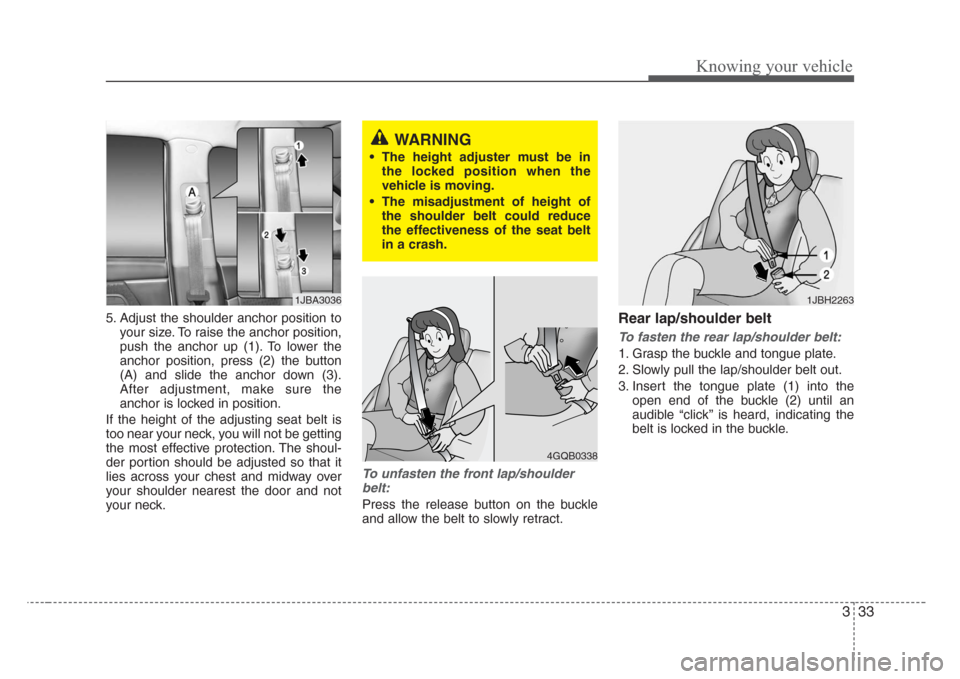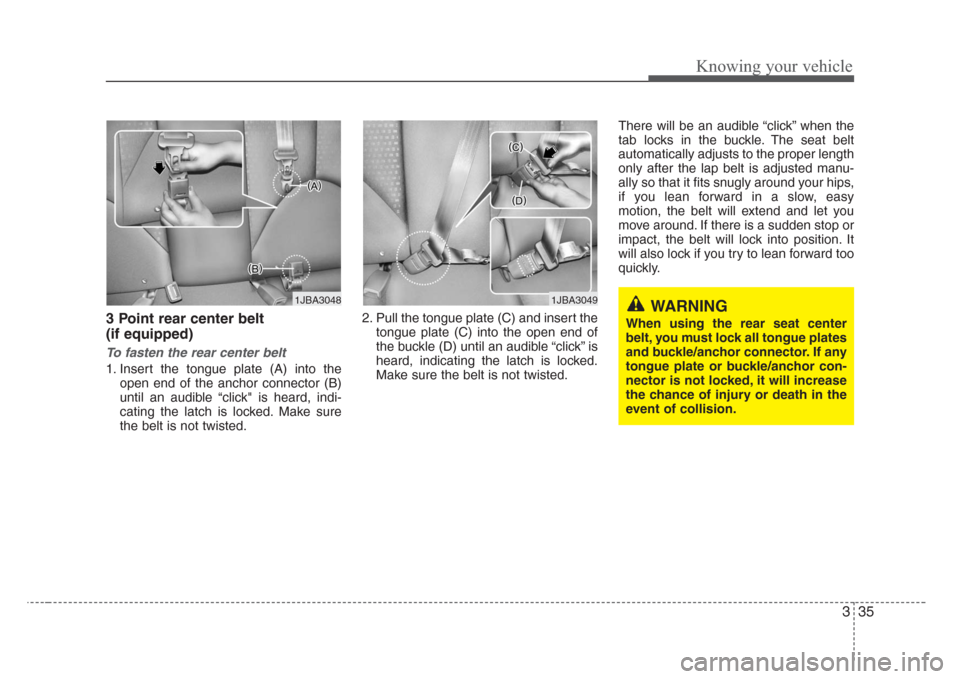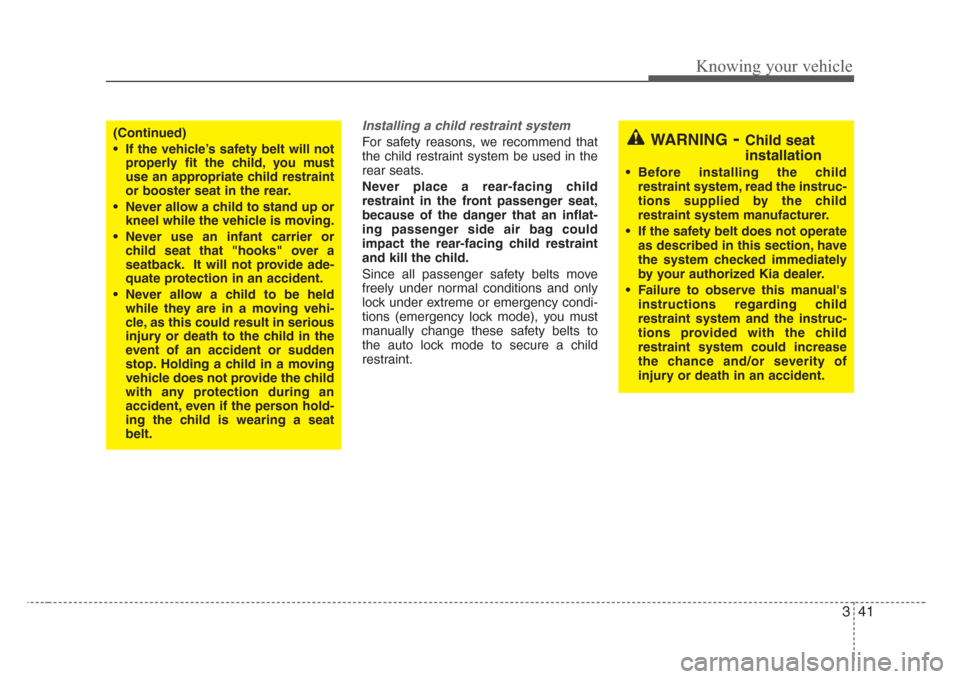Page 33 of 219
Knowing your vehicle
24 3
6. Pull up on the rear seatback lock
release lever (5). If the seatback is
unlocked, red mark (a) of knob
becomes visible.
7. Fold the seatback forward and down
firmly (6).✽
NOTICE- Damaging rear safe-
ty buckles
When you fold the rear seatback or put
luggage on the rear seat cushion, insert
the buckle in the pocket between the
rear seatback and cushion. Doing so can
prevent the buckle from being damaged
by the rear seatback or luggage.
✽
NOTICE- Rear safety belts
Routing the safety belt webbing through
the rear safety belt guides will help keep
the belts from being trapped behind or
under the seats. When returning the
rear seatbacks to the upright position,
remember to return the rear shoulder
belts to their proper position.
1JBA3506
1JBA3507
(a)
1JBA3215
(if equipped)
1JBE3053
1JBE3053A
4 Door
5 Door
Page 34 of 219

325
Knowing your vehicle
To unfold the rear seat:
1. Move the rear lap/shoulder belt (1, if
equipped) to the side so that it is clear
of the seatback.
2. Lift and push the seatback backward
firmly until it clicks into place (2).
3. Move and push the headrest and the
seat cushion downward firmly to the
proper position (5 Door, if equipped).
4. Return the rear safety belt to the prop-
er position.
✽
NOTICE
If the seat belt is locked during the seat-
back folding, pull out and retract the
seat belt to release it.
1JBA3030
CAUTION
• When returning the rear seat-
backs to the upright position,
remember to return the rear
shoulder belts to their proper
position.
• Do not remove the floor carpet in
your vehicle. Emission control
system components cause high
exhaust temperatures under the
floor.
WARNING- Cargo
Cargo should always be secured to
prevent it from being thrown about
the vehicle in a collision and caus-
ing injury to the vehicle occupants.
CAUTION
• Make sure the engine is off, the
transaxle is in P and the parking
brake is applied whenever load-
ing or unloading cargo. Vehicle
may move if shift lever is inadver-
tently moved to another position.
• Be careful when loading cargo
through the rear passenger seats
to prevent damage to the vehicle
interior.
• When cargo is loaded through the
rear passenger seats,ensure the
cargo is properly secured to pre-
vent it from moving while driving.
Unsecured cargo in the passen-
ger compartment can cause dam-
age to the vehicle or injury to it’s
occupants.
Page 38 of 219

329
Knowing your vehicle
Safety belt restraint system We strongly recommend that the driver
and all passengers be properly
restrained at all times by using the safety
belts provided with the vehicle. Proper
use of the safety belts decreases the risk
of severe injury or death in accidents or
sudden stops. In most states, and in
Canada, the law requires their use.
All seats have lap/shoulder belts. Inertial
locks in the safety belt retractors allow all
of the lap/shoulder safety belts to remain
unlocked during normal vehicle opera-
tion. This allows the occupants some
freedom of movement and increased
comfort while using the safety belts. If a
force is applied to the vehicle, such as a
strong stop, a sharp turn, or a collision,
the safety belt retractors will automatical-
ly lock the safety belts.
Since the inertial locks do not require a
collision in order to lock up, you may
become aware of the safety belts locking
while braking or going around sharp cor-
ners.
Always use the rear seat position(s) to
install your child restraint(s).The rear safety belts use a special auto-
lock feature designed to allow a child
restraint to be used in these positions
without an added locking clip. They nor-
mally lock only under extreme or emer-
gency conditions (emergency lock
mode). However they can be adjusted so
that they remain fixed and locked when a
child restraint system is placed in these
positions. (Use this auto-lock mode only
to secure a child restraint, never for pas-
sengers restrained by the safety belts.)
Page 3-42 gives instructions on placing
the safety belt in the auto lock mode.
The drivers safety belt can only operate
in the emergency lock mode.
WARNING- Safety belts
To minimize the risk of serious or
fatal injury in an accident, the driv-
er and all passengers should use
the appropriate safety restraints for
their age and size. The presence of
air bags does not change the need
to be properly restrained by a safe-
ty belt or size-appropriate child
restraint. In fact, air bags are
designed to work the best when
passengers are correctly restrained
in the vehicle.
• Be sure you are familiar with the
information in this section,
including the information on
infant and child restraints.
• Read the safety warnings on the
sun visors of your vehicle also.
WARNING- Child restraint
in front seat
Never install a child restraint sys-
tem in the front passenger position,
as an inflating air bag could cause
serious or fatal injury to a child in
that position.
Page 41 of 219
Knowing your vehicle
32 3
Lap/shoulder belt
To f asten the front lap/shoulder belt:
1. Grasp the buckle and tongue plate.
2. Slowly pull the lap/shoulder belt out
from the retractor.3. Insert the tongue plate (1) into the
open end of the buckle (2) until an
audible “click” is heard, indicating the
belt is locked in the buckle.4. Position the lap portion (1) of the belt
across your lap as LOW ON THE HIPS
as possible to reduce the risk of sliding
under it during an accident. Adjust the
belt to a SNUG FIT by pulling up on
the shoulder portion (2) of the safety
belt. The belt retractor is designed to
take up excess webbing automatically
and to maintain tension on the belt. For
your safety, do not put any excess
slack into the safety belt at any loca-
tion.
1JBH22631JBH22641GHA2262
Page 42 of 219

333
Knowing your vehicle
5. Adjust the shoulder anchor position to
your size. To raise the anchor position,
push the anchor up (1). To lower the
anchor position, press (2) the button
(A) and slide the anchor down (3).
After adjustment, make sure the
anchor is locked in position.
If the height of the adjusting seat belt is
too near your neck, you will not be getting
the most effective protection. The shoul-
der portion should be adjusted so that it
lies across your chest and midway over
your shoulder nearest the door and not
your neck.
To unfasten the front lap/shoulder
belt:
Press the release button on the buckle
and allow the belt to slowly retract.
Rear lap/shoulder belt
To f asten the rear lap/shoulder belt:
1. Grasp the buckle and tongue plate.
2. Slowly pull the lap/shoulder belt out.
3. Insert the tongue plate (1) into the
open end of the buckle (2) until an
audible “click’’ is heard, indicating the
belt is locked in the buckle.
4GQB0338
1JBA30361JBH2263
WARNING
• The height adjuster must be in
the locked position when the
vehicle is moving.
• The misadjustment of height of
the shoulder belt could reduce
the effectiveness of the seat belt
in a crash.
Page 44 of 219

335
Knowing your vehicle
3 Point rear center belt
(if equipped)
To f asten the rear center belt
1. Insert the tongue plate (A) into the
open end of the anchor connector (B)
until an audible “click" is heard, indi-
cating the latch is locked. Make sure
the belt is not twisted.2. Pull the tongue plate (C) and insert the
tongue plate (C) into the open end of
the buckle (D) until an audible “click” is
heard, indicating the latch is locked.
Make sure the belt is not twisted.There will be an audible “click” when the
tab locks in the buckle. The seat belt
automatically adjusts to the proper length
only after the lap belt is adjusted manu-
ally so that it fits snugly around your hips,
if you lean forward in a slow, easy
motion, the belt will extend and let you
move around. If there is a sudden stop or
impact, the belt will lock into position. It
will also lock if you try to lean forward too
quickly.
1JBA3048WARNING
When using the rear seat center
belt, you must lock all tongue plates
and buckle/anchor connector. If any
tongue plate or buckle/anchor con-
nector is not locked, it will increase
the chance of injury or death in the
event of collision.
1JBA3049
Page 45 of 219
Knowing your vehicle
36 3
When using the rear center seat belt, the
buckle with the “CENTER” mark must be
used.
Stowing the rear safety belt
The rear safety belt buckles can be
stowed in the pocket between the rear
seatback and cushion when not in use.
1JBN3046
1JBE3053
1JBE3053A
4 Door
5 Door
WARNING
• When using the rear center belt,
you must lock all tongue plates
and buckles prior to use. If any
tongue plate or buckle is not
locked, it will increase the chance
of injury or death in the event of
collision.
• The rear center seatbelt tongue
plate (A) and anchor connector
(B) should remain locked at all
times. They should only be
unlocked when folding the rear
seatback down or when carrying
an object in the rear seat that
could cause damage to the seat-
belt webbing or locking devices.
In either case, lock the tongue
plate (A) and anchor connector
(B) immediately after unfolding
the seatbacks or removing the
object being transported.
Page 50 of 219

341
Knowing your vehicle
Installing a child restraint system
For safety reasons, we recommend that
the child restraint system be used in the
rear seats.
Never place a rear-facing child
restraint in the front passenger seat,
because of the danger that an inflat-
ing passenger side air bag could
impact the rear-facing child restraint
and kill the child.
Since all passenger safety belts move
freely under normal conditions and only
lock under extreme or emergency condi-
tions (emergency lock mode), you must
manually change these safety belts to
the auto lock mode to secure a child
restraint.(Continued)
• If the vehicle’s safety belt will not
properly fit the child, you must
use an appropriate child restraint
or booster seat in the rear.
• Never allow a child to stand up or
kneel while the vehicle is moving.
• Never use an infant carrier or
child seat that "hooks" over a
seatback. It will not provide ade-
quate protection in an accident.
• Never allow a child to be held
while they are in a moving vehi-
cle, as this could result in serious
injury or death to the child in the
event of an accident or sudden
stop. Holding a child in a moving
vehicle does not provide the child
with any protection during an
accident, even if the person hold-
ing the child is wearing a seat
belt.WARNING-Child seat
installation
• Before installing the child
restraint system, read the instruc-
tions supplied by the child
restraint system manufacturer.
• If the safety belt does not operate
as described in this section, have
the system checked immediately
by your authorized Kia dealer.
• Failure to observe this manual's
instructions regarding child
restraint system and the instruc-
tions provided with the child
restraint system could increase
the chance and/or severity of
injury or death in an accident.